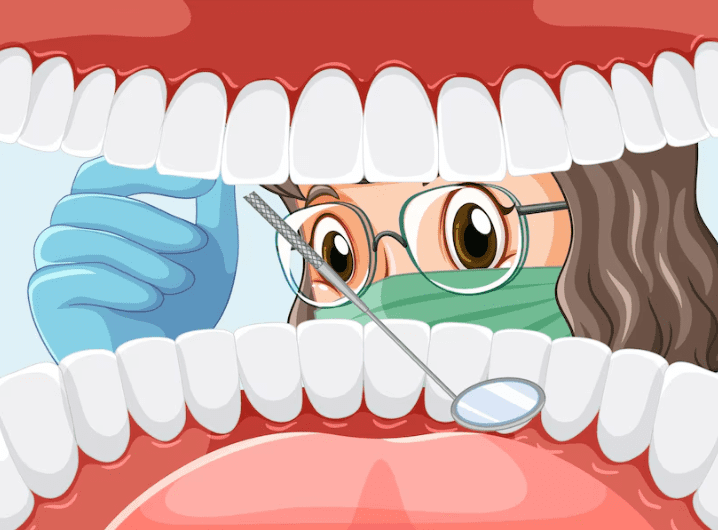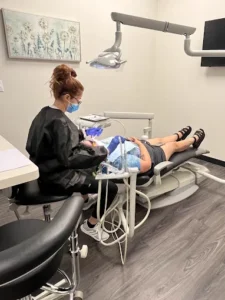A hole in gums can be a sign of a bigger oral health problem, often related to gum disease or infections. Whether the gum infection comes from periodontitis, an infection, or a tooth extraction site, it’s essential to understand what causes it, how to treat it, and ways to prevent it. This guide covers everything you need to know about a gum tissue damage, giving you helpful advice on how to manage it effectively.
What a Hole in Gums Means
When you notice a gum tissue damage, it often means there’s damage or disease. Gums are soft tissues that protect your teeth and play an important role in overall oral health. A gum infection, caused by infection or gum disease, can lead to more serious problems if left untreated.
Common Causes of Gum Damage
The type of damage to your gums will determine the best way to treat it. Here are some common causes of damage that lead to a Gum infection:
1. Periodontitis
Periodontitis is a serious form of gum disease caused by bacteria in plaque. It starts as gingivitis, a mild inflammation, but if untreated, it can destroy the bones and tissues around your teeth, forming pockets or holes in gums. About 47.2% of adults have some level of periodontal disease.
-
Chronic Periodontitis:
This long-lasting form of the disease creates deep pockets between your gums and teeth.
-
Aggressive Periodontitis:
This fast-moving condition leads to severe gum recession and often tooth loss.
-
Necrotizing Periodontal Disease:
A rare, but serious condition that involves tissue death, often found in people with weakened immune systems.
2. Infections:
Bacterial and viral infections can also cause holes in gums. For example, herpetic gingivostomatitis can lead to crater-like sores. Rare infections like actinomycosis, have been documented (NCBI) can also cause major damage to gum tissue .
3. Open Tooth Socket:
After having a tooth pulled, it’s normal to have a gum infection where the tooth used to be. This socket should heal within eight weeks (Frontiers in Physiology), but if it doesn’t heal properly, it can cause a painful condition called a dry socket, where the bone and nerves are exposed.
4. Necrotizing Periodontal Disease:
This severe condition leads to the death of gum tissue and can create deep holes in gums. People with weakened immune systems are more likely to suffer from this disease.
Is A Gum Tissue Damage Dangerous?
A gum tissue damage can lead to various issues if not treated right away. The level of danger depends on the cause and how severe the damage is:
-
Mild damage:
like small holes in gums or early gum disease, can cause discomfort and sensitivity.
-
Moderate damage:
such as periodontitis, can cause gum recession, bone loss, and even tooth loss.
-
Severe damage:
from necrotizing disease or large infections needs immediate attention to prevent more tissue loss and the spread of infection.
Treatment Options for a Gum recession
The treatment for a gum recession depends on what caused it and how bad the damage is. Your dentist will suggest the best treatment for your situation.
1. Scaling and Root Planing:
This deep cleaning method is often used to treat periodontitis. Scaling removes plaque from below the gum line, and root planing smooths the tooth roots, helping the gums reattach to the teeth. This method is effective in shrinking pockets or holes in gums.
2. Pocket Reduction Surgery (Flap Surgery):
For deep pockets caused by gum disease, flap surgery may be necessary. The gums are pulled back to clean the roots deeply, and then stitched back to reduce the pocket depth and encourage healing.
3. Gum Grafting:
If a pus in gums is caused by gum recession, your dentist might recommend a gum graft. This involves taking tissue from another part of your mouth and covering the exposed tooth roots to prevent further damage and restore the gum line.
4. Bone Grafting:
In severe cases of periodontitis where bone loss has occurred, bone grafting is used to help regrow lost bone. A graft material is placed in the area to stimulate new bone growth.
5. Antibiotics:
Infections that cause holes in gums might need antibiotics to remove harmful bacteria. These medicines can be taken by mouth or applied directly to the infected area to promote healing.
Preventing Holes in Gums
Preventing gum disease and other problems that lead to a pus in gums is important for keeping your mouth healthy. Here’s how you can reduce your risk:
-
Brush and floss regularly:
Keeping good oral hygiene is the first step in preventing gum disease. Brush twice a day and floss daily to remove plaque from your teeth and gums.
-
Use a soft-bristled toothbrush:
Brushing too hard can harm your gums and make them more likely to get damaged.
-
Avoid sugary foods:
Sugar feeds the bacteria that cause plaque and gum disease. Try to limit sugary snacks and drinks.
-
Don’t smoke:
Smoking weakens your immune system, making you more likely to develop gum disease.
-
Visit your dentist regularly:
Get professional cleanings and exams every six months. Catching gum disease early can prevent it from getting worse.
Get Professional Treatment at Celebrate Dental Austin
If you notice a hole in your gums or feel discomfort, it’s important to get help quickly to avoid more complications. At Celebrate Dental Austin, we specialize in treating a range of gum issues, from periodontal disease to post-extraction problems.
Our skilled team offers custom treatments like scaling and root planing, flap surgery, and gum grafting to help restore your gum health and prevent further damage.
Don’t wait for the problem to get worse— schedule a consultation with our experienced dental team today. Visit us online or call 512-521-7000 to discuss the best treatment plan for your pus in gums and take control of your oral health.









